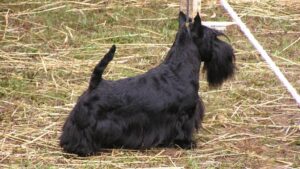
Celebrate the Scottish Terrier
Scottie owners are devoted, like their dogs. Discover the unique bond, traits, and challenges of owning a Scottie.
Home » Dog Breeds » Scottish Terrier Dog Breed
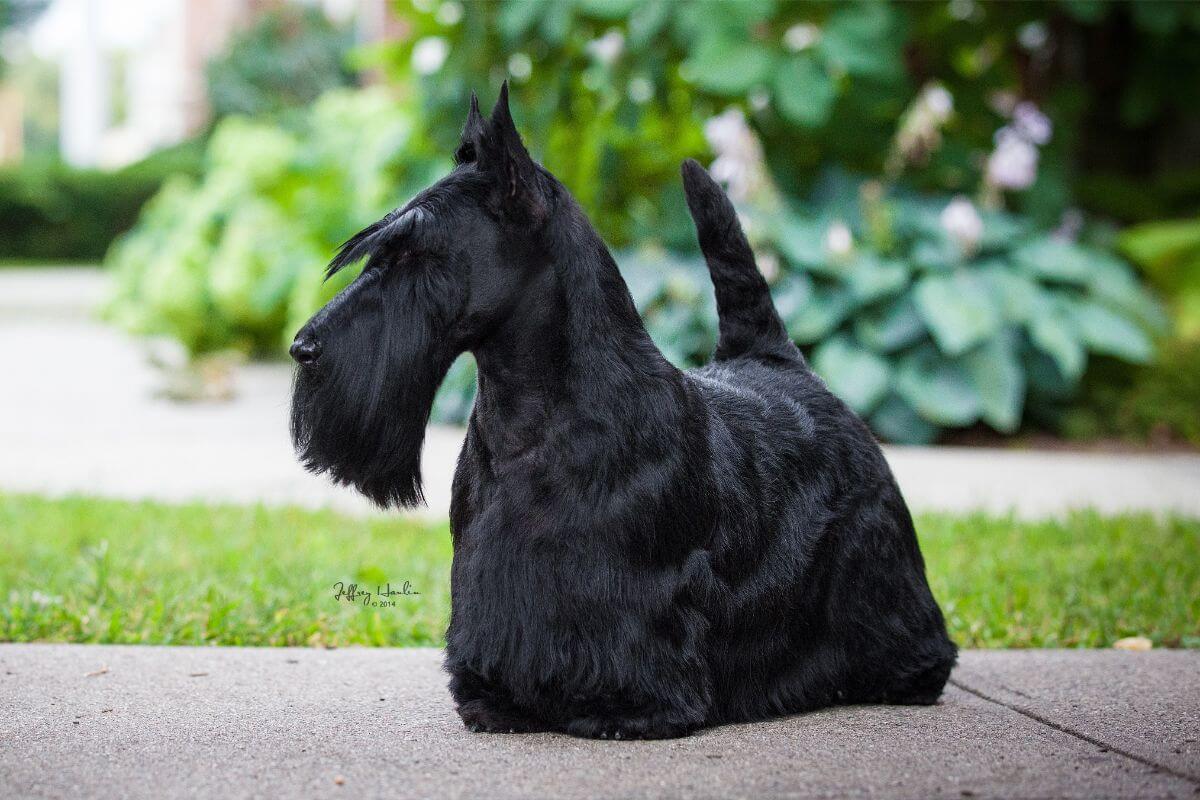

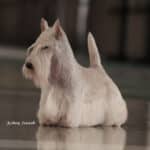


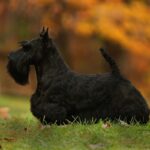
The Scottish Terrier, affectionately known as the “Scottie,” is a breed that epitomizes determination and confidence. Characterized by its distinctive profile and dignified demeanor, this breed has a storied history as a skilled vermin hunter and hardy companion. Originating from the rugged terrain of Scotland, the breed is cherished today not only for its hunting prowess but also for its rugged and independent nature. Compact and sturdy, Scotties possess a charm that appeals to both show enthusiasts and pet people alike.
Terrier
10 inches
18 – 22 pounds
12 years
| Country of Origin | Scotland |
|---|---|
| Bred For | Vermin Hunting, Companionship |
| Known For | Short Legs, Independence, Stubbornness |
| Popularity | Moderate |
| Temperament | Alert, Determined, Spirited |
| Activities | Hunting, Walking, Hiking, Conformation Shows, Dog Sports |
The Scottish Terrier dog breed boasts a heritage rich in history and character. This breed’s journey from Scotland’s rugged landscapes to the hearts of dog lovers worldwide is a testament to its enduring appeal.
Originating in Scotland, Scottish Terriers were initially bred for their prowess in hunting and vermin control. Their compact size and agile physique made them ideal for navigating the rough terrain of the Scottish Highlands. The breed’s early history saw them lumped together with other terriers of the region, but by the late 19th century, efforts were made to distinguish and refine the Scottish Terrier as a distinct breed.
The rise of the Scottish Terrier is marked by the development of specific breeding programs in the late 1800s. These programs were dedicated to enhancing the breed’s unique characteristics, including its robust build, distinctive coat, and bold personality. The breed’s standardization was a significant step in establishing its identity separate from other terrier types native to Scotland.
Scottish Terriers gained widespread popularity in the United Kingdom, capturing the imagination of dog enthusiasts with their courage, confidence, and distinctive appearance. Their charm soon crossed the Atlantic, leading to a surge in popularity in the United States. The breed was one of the early members of the American Kennel Club’s Terrier Group, receiving official recognition in 1885.
The breed’s stature grew further in the United States, particularly when several U.S. Presidents chose Scottish Terriers as their companions, elevating the breed’s profile in American culture. Despite the changes in breeding practices and shifts in popularity over the years, the Scottish Terrier has remained a symbol of determination and rugged charm.
Throughout its history, the Scottish Terrier has been celebrated for its unique character and steadfast loyalty. Whether in the show ring or as a beloved family pet, the Scottie continues to be a favorite for its distinctive personality and appearance. The breed’s history, from its origins in the Scottish Highlands to its current status as a cherished companion, highlights the enduring legacy of the Scottish Terrier.
Adult Scottish Terriers typically stand about 10 inches tall at the shoulder. In terms of weight, males generally weigh between 19 to 22 pounds, with females usually in the range of 18 to 21 pounds.
The Scottish Terrier boasts a compact body with a robust bone structure, endowing it with a solid and substantial feel. Proportionally, the Scottish Terrier is longer than it is tall, measured from the back of the withers to the set-on of the tail and from the top of the withers to the ground. These proportions contribute to the breed’s distinctive gait, which combines power and vigor with smoothness and fluidity. Substantial bone, coupled with a muscular build, endows the Scottie with remarkable strength and agility, qualities that are essential for a breed historically bred for digging and hunting vermin.
Texture: The Scottish Terrier’s coat is a distinctive breed feature, notable for its unique “broken” texture. It boasts a hard, wiry outer coat and a soft, dense undercoat. This dual layer not only gives the breed its characteristic appearance, it also serves as protection against harsh weather and rough terrain. The coat is typically trimmed (by hand), blending the topcoat with the longer furnishings to create the breed’s classic silhouette which is enhanced by longer coat on the beard, eyebrows, lower body, and legs.
| Standard Color | |
|---|---|
| Black | ee |
| Black Brindle | ee |
| Brindle | ee |
| Red Brindle | ee |
| Silver Brindle | ee |
| Wheaten | ee |
A Note About Color: The properties of the Scottish Terrier’s coat are more important than the coat’s color. The breed may be solid or brindled, darker or lighter in a variety of acceptable colors. Brindle-colored dogs can have varying shades and depths of color; wheaten dogs can range from a deep red to more a pale coloration; black dogs can have a small amount of white on the chin (known as a “milk beard”). A few white hairs may also be found on the body coat, but an all-white coat is unacceptable. However, rare colors, such as solid red and sandy, are sometimes seen in the breed and are permissible.
The tail of a Scottish Terrier is moderate in length, about seven inches long, providing a balance with the head’s carriage. It is set high and carried erectly or may be slightly curved forward. It does not curl over the back. The tail is thick at its base, covered in short, hard hair, and tapers to a fine point.
The Scottie’s tail is never docked. Its natural length and carriage have historically enabled the dog to be pulled safely from burrows where it has cornered unwanted (and dangerous) vermin. The tail is a symbol of the breed’s confidence in itself and its capacity to meet any challenge head-on.
Owning a Scottish Terrier, known for its distinct personality and dignified demeanor, is a rewarding experience for dog lovers. However, it’s important to understand the unique characteristics and needs of this breed to ensure a harmonious relationship between the dog and its human companion. Scottish Terriers, with their independent nature and strong-willed temperament, require an owner who can provide firm, consistent training and a structured environment.
Scottish Terriers are generally hardy and robust dogs, known for their longevity and resilience. However, as with any breed, they can be prone to certain health conditions that potential owners should be aware of. It is essential to engage with reputable breeders who conduct health screenings and to maintain regular veterinary check-ups to monitor and maintain the health of your Scottish Terrier.
The average lifespan of a Scottish Terrier is around 12 years. With attentive care, a nutritious diet, and regular exercise, many Scottish Terriers can enjoy a full and healthy life, often surpassing the average lifespan.
Scottish Terriers, like all breeds and mixed breeds, have certain health risks that potential owners should be aware of. Some common health issues in Scottish Terriers include:
Understanding these health risks is crucial for Scottish Terrier owners. Regular veterinary check-ups, a balanced diet, and a healthy lifestyle are key to managing these conditions and ensuring a long, healthy life for your Scottie.
The personality of the Scottish Terrier is as distinctive as its appearance. Known for their independent and somewhat stubborn nature, these dogs possess a charm that is both endearing and challenging. Their strong-willed character means they often do best with experienced dog owners who understand the nuances of terrier temperaments.
Scottish Terriers are not typically recommended for novice dog owners, as they require consistent and patient training. Their sensitivity level is moderate; they respond well to positive reinforcement but can become withdrawn if treated harshly. While they can enjoy periods of solitude, Scottish Terriers also thrive on interaction and should not be left alone for extended periods.
When it comes to socializing with other dogs, Scottish Terriers can be selective. Early socialization is key to helping them develop good canine manners. They are generally good with older children who understand how to interact with dogs respectfully, but their tolerance may not extend to very young, energetic children.
In terms of their friendliness towards strangers, Scottish Terriers can be aloof. They are loyal to their family and can be reserved around new people, often sizing up strangers before deciding to engage with them.
Owners of Scottish Terriers should be prepared for a dog with a strong personality, one that requires understanding, patience, and a sense of humor to fully appreciate all the qualities that make this breed so unique.
Proper feeding and nutrition are crucial for the health and well-being of a Scottish Terrier. The dietary needs of a Scottish Terrier vary from puppyhood to adulthood, and it’s important to tailor their diet accordingly.
For puppies, a balanced diet specifically formulated for small-breed puppies is recommended. Puppies have higher energy needs, so their diet should be rich in protein and fat to support their growth and development. It’s generally advised to feed Scottish Terrier puppies three to four small meals per day.
As they transition into adulthood, the dietary focus shifts towards maintaining a healthy weight and supporting overall health. Adult Scottish Terriers typically do well on two meals per day. The amount of food depends on the dog’s size, age, activity level, and metabolism. On average, an adult Scottish Terrier might require about 1 to 1.5 cups of high-quality dry dog food per day, divided into two meals. However, these are just guidelines, and it’s important to adjust the portion sizes based on the dog’s individual needs and to prevent obesity.
When it comes to nutrition, look for foods that list meat as the primary ingredient and avoid those with excessive fillers or artificial additives. Also, having fresh water available at all times is essential for their hydration.
Lastly, regular check-ups with a veterinarian can help monitor the Scottish Terrier’s weight and overall health, making sure that their diet continues to meet their nutritional needs throughout their life stages.
Training a Scottish Terrier can be a unique experience due to their intelligent yet independent nature. While they are capable of learning quickly, they often display a stubborn streak, which can pose a challenge during training sessions. Consistency, patience, and positive reinforcement are key in successfully training a Scottish Terrier.
Scottish Terriers are not the easiest breed to train, especially for first-time dog owners. They require a handler who understands canine psychology and can establish themselves as a calm, assertive leader. This breed responds well to training that is engaging and varied, as repetitive tasks may lead to boredom.
When it comes to barking, Scottish Terriers have a moderate tendency. They may bark to alert their owners of something unusual, but are not typically excessive barkers. Training from a young age to understand the command to stop barking is beneficial.
Intelligence is a prominent trait in Scottish Terriers. They are quick learners and can excel in various dog sports and activities. However, their independent thought process means they might not always follow commands blindly.
Wanderlust potential in Scottish Terriers is relatively low compared to other breeds. While they enjoy exploring, their loyalty to their home and family usually keeps them from straying too far. Nonetheless, a secure, fenced area is recommended for outdoor activities.
Predation is a natural instinct in Scottish Terriers, stemming from their history as hunting dogs. They may chase smaller animals, so it’s important to manage this behavior through training and socialization.
Exercise for a Scottish Terrier should be a well-balanced mix of physical activity and mental stimulation. These dogs have a moderate to high energy level, making them lively and playful. They thrive on a combination of daily walks, interactive play sessions, and activities that challenge their minds.
| Energy Level | Moderate |
|---|---|
| Exercise Requirements | 45 Minutes/Day (Minimum), Daily Walks, Vigorous Running, Regular Exercise, Playing with Another Dog, Mental Stimulation |
Their exercise needs are moderate. A couple of brisk walks each day, along with some playtime, usually suffices to keep a Scottish Terrier healthy and content. These activities not only cater to their physical health but also provide essential mental stimulation. Playful interactions, such as fetch or tug-of-war, are particularly enjoyed by this breed and serve to strengthen the bond between the dog and its owner.
While Scottish Terriers are energetic, the intensity of their exercise should not be overly strenuous. They enjoy activities that are engaging but don’t typically require or tolerate highly intense workouts. It’s important to consider each individual dog’s health, age, and fitness level when planning their exercise routine.
The playful nature of Scottish Terriers can’t be overstated. They relish opportunities to play and interact with their human companions. This aspect of their exercise regime is crucial for their emotional well-being. Regular play sessions help keep them mentally sharp and emotionally satisfied.
Grooming a Scottish Terrier is an essential aspect of their care, not only for maintaining their distinctive appearance but also for their overall health. The unique coat of the Scottish Terrier requires regular grooming to keep it in good condition.
| Coat Type | Broken-haired, Hard, Wiry, Dense, Trimmed |
|---|---|
| Grooming Requirements | Weekly Brushing, Occasional Bathing, Monthly Nail Trimming, Weekly Tooth Brushing |
Scottish Terriers have a double coat, with a hard, wiry outer coat and a soft, dense undercoat. This type of coat requires regular brushing to prevent matting and to remove loose hair. Brushing a couple of times a week is usually sufficient to keep their coat healthy and to manage shedding. The wiry top coat also needs to be hand-stripped or clipped several times a year to maintain the breed’s characteristic appearance. This process involves removing dead hair and helps to keep the coat’s texture.
While they do shed, Scottish Terriers are not heavy shedders compared to many other breeds. Regular grooming will help to minimize the amount of hair they leave around the house.
In addition to coat care, other grooming needs include regular nail trimming, as overly long nails can cause discomfort and problems walking. Ear cleaning is also important to prevent infections, particularly since their small, erect ears can trap dirt. Regular dental care, including teeth brushing or dental chews, is essential for maintaining oral health.
Grooming is also an excellent opportunity to check for any skin issues, lumps, or signs of infection that might need veterinary attention. Starting grooming routines early in life will help your Scottish Terrier become accustomed to being handled and make the process easier for both the dog and the groomer.
Living with a Scottish Terrier can be a delightful experience, but it’s important to consider their specific needs to provide a harmonious household. These dogs are adaptable to various living environments, but like all breeds, they have certain preferences and requirements.
Apartment living is generally suitable for Scottish Terriers. They are small enough to fit comfortably in smaller spaces and do not require a large yard. However, their moderate energy level means they still need daily exercise and mental stimulation. Regular walks and play sessions are essential, even in an apartment setting, to keep them happy and prevent boredom.
In terms of weather tolerance, Scottish Terriers have a dense double coat that provides them with good insulation. This makes them fairly tolerant of cold weather. They enjoy brisk walks in cooler temperatures, but it’s important to monitor them to make sure that they don’t get too cold, especially in extreme conditions.
Conversely, their tolerance for hot weather is somewhat lower due to their thick coat. In warmer climates or during hot weather, it’s crucial to make sure that they don’t overheat. Providing access to shade, fresh water, and avoiding intense exercise during the hottest parts of the day will help keep them comfortable.
When considering bringing a Scottish Terrier into your home, it’s also important to think about their strong-willed and independent nature. They can be territorial and may require training to manage any tendencies towards stubbornness or possessiveness. Early socialization and consistent training are key to helping them become well-adjusted members of the family.
Overall, the Scottish Terrier can make a wonderful companion in various living situations, provided their exercise, mental stimulation, and training needs are met. Their adaptable nature, coupled with their unique personality, makes them a cherished pet for the right owner.
Welcoming a Scottish Terrier puppy into your home is an exciting journey filled with challenges and joys. These puppies are energetic, curious, and often full of spunk, embodying the breed’s characteristic traits from an early age. It’s important for new owners to understand the specific needs of Scottish Terrier puppies to help them grow into well-adjusted, healthy adult dogs.
Caring for Scottish Terrier puppies involves several key aspects. Firstly, nutrition is crucial; they require a balanced diet formulated for small-breed puppies. This diet should support their rapid growth and development in their first months. Puppies have higher energy needs than adults, so feeding them small, frequent meals is recommended.
Early socialization and exposure to a variety of people, sounds, and experiences are essential in shaping a well-behaved adult Scottish Terrier. This breed can be somewhat reserved and independent, so early socialization helps to build confidence and ease in different situations.
Training should begin as soon as a puppy comes home. Scottish Terriers are intelligent and capable of learning quickly, but they can also be stubborn. Consistent, positive reinforcement methods work best for training, with a focus on basic commands and house training. Crate training can also be an effective tool for housebreaking and providing a safe space for the puppy.
Regular veterinary check-ups are important for monitoring the puppy’s health, receiving vaccinations, and discussing spaying or neutering. These visits are also an opportunity to learn about preventive care, such as flea and tick control and heartworm prevention.
Exercise for puppies should be moderate; too much rigorous activity can be hard on their developing bodies. Short walks and play sessions are ideal for expending energy and encouraging healthy growth.
Lastly, grooming should be introduced early. Getting a Scottish Terrier puppy accustomed to regular brushing, nail trims, and ear cleaning from a young age will make grooming a much easier process as they grow older.
Scottish Terriers are well-suited for a variety of activities and dog sports that can provide mental and physical stimulation. Participating in these activities not only keeps them fit but also strengthens the bond between the dog and its owner. Here are some activities and dog sports in which Scottish Terriers can excel:
These activities provide excellent outlets for a Scottish Terrier’s energy and intelligence. They also offer opportunities for socialization and can be a fun way for owners to deepen their relationship with their dog.
The Scottish Terrier is recognized by the world’s leading registries and kennel organizations, which categorize the breed into a specific Group based on its unique characteristics. This breed is recognized worldwide under the following Group designations:
| Organization | Group Designation |
|---|---|
| AKC (American Kennel Club) | Terrier |
| UKC (United Kennel Club) | Terrier |
| CKC (Canadian Kennel Club) | Terriers |
| ANKC (Australian National Kennel Council) | Terriers |
| RKC (The Royal Kennel Club) | Terrier |
| FCI (Fédération Cynologique Internationale) | Group 3: Terriers; Section 2: Small-Sized Terriers |
The ideal Scottish Terrier is described by a Breed Standard that is approved by each of the world’s leading registries and kennel organizations. The Breed Standards for this breed may be found in the following links:
| Organization | Breed Standard |
|---|---|
| American Kennel Club | AKC Scottish Terrier Breed Standard |
| United Kennel Club | UKC Scottish Terrier Breed Standard |
| Canadian Kennel Club | CKC Scottish Terrier Breed Standard |
| Australian National Kennel Council | ANKC Scottish Terrier Breed Standard |
| The Royal Kennel Club | RKC Scottish Terrier Breed Standard |
| Fédération Cynologique Internationale | FCI Scottish Terrier Breed Standard |
Scottish Terrier Clubs play a vital role in the preservation, promotion, and understanding of the breed. These clubs offer a wealth of resources for both seasoned and prospective Scottish Terrier owners, providing opportunities for education, community, and breed advocacy.
In the United States, the Scottish Terrier Club of America (STCA) stands out as a key organization. It is dedicated to the overall welfare of the breed and offers extensive information on breed standards, health and grooming, training, and rescue efforts. The STCA also organizes events, shows, and meetups, fostering a sense of community among Scottie enthusiasts.
In Canada, the Canadian Scottish Terrier Club serves a similar purpose, supporting the breed through various activities, educational resources, and events. It aims to uphold the integrity of the breed and offers a platform for Canadian owners and breeders to connect and share their love for Scottish Terriers.
In the United Kingdom, the Scottish Terrier Club England plays an instrumental role. It provides resources, organizes events, and promotes the health and well-being of Scottish Terriers in the region. This club also works to maintain the breed’s standards and serves as a hub for Scottish Terrier owners and admirers in the UK.
Being a part of a Scottish Terrier Club can be a rewarding experience for anyone passionate about the breed. It offers a sense of belonging to a community that shares a common love for these unique dogs, and provides an avenue for contributing to the breed’s future.
Scottish Terriers sometimes find themselves in need of new homes due to various reasons such as changes in owner circumstances, health issues, or behavioral challenges. Scottish Terrier rescue groups are dedicated to helping these charismatic dogs find caring and suitable forever homes, while also offering education and support to potential adopters.
In the United States, one of the key organizations involved in Scottish Terrier rescue is the Scottish Terrier Club of America (STCA). The STCA operates a rescue program that spans across various states, providing assistance and support to Scottish Terriers in need. This group is committed to the welfare of homeless or displaced Scottish Terriers, working diligently to rehabilitate and rehome them.
For those interested in adopting a Scottish Terrier, it’s also worth considering local shelters and general breed rescues. While breed-specific rescues are invaluable, some Scottish Terriers find their way into more general animal rescue organizations. These local shelters often have a variety of breeds, including Scottish Terriers, in need of loving homes.
Scottish Terriers are often considered hypoallergenic due to their unique coat type. They have a wiry topcoat and a soft undercoat, which tend to shed less than other breeds. However, no dog is truly hypoallergenic. People with allergies may react differently to individual dogs, but Scottish Terriers are generally a better option for allergy sufferers compared to many other breeds.
Scottish Terriers have a moderate tendency to bark. They may bark to alert their owners of something unusual, but they are not known for excessive barking without cause. Training from a young age to understand and respond to commands can help manage any undesirable barking behavior.
Scottish Terriers do shed, but generally less than many other dog breeds. Their double coat, comprising a hard, wiry outer coat and a soft undercoat, loses hair less frequently. Regular grooming, including brushing and occasional stripping of the coat, helps to minimize shedding.
Scottish Terriers are a small breed, typically standing about 10 inches tall at the shoulder. In terms of weight, males generally weigh between 19 to 22 pounds, and females weigh between 18 to 21 pounds. Their compact size makes them suitable for various living environments.
Scottish Terriers are not particularly known for their speed, but they are agile and can move quickly when motivated. They were bred for hunting, which required bursts of speed, especially when pursuing vermin. However, they are not built for sustained high-speed running like some larger breeds.
The average lifespan of a Scottish Terrier is around 12 years. With proper care, including a balanced diet, regular exercise, and consistent veterinary check-ups, many Scottish Terriers can live into their teenage years, enjoying a relatively long and healthy life.
Scottish Terriers can be good family dogs, especially in homes that understand their unique temperament. They are loyal and can form strong bonds with family members. However, their independent nature and moderate tolerance for young children mean they are better suited for families with older children who understand how to interact with dogs.
Scottish Terriers are not typically used as service dogs. Their independent and sometimes stubborn nature might not align well with the consistent and predictable behavior required in service dogs. However, they can excel in other roles like companionship and potentially emotional support, given their loyal nature.
Historically, Scottish Terriers were excellent hunting dogs, particularly adept at hunting vermin and small game. Their small size, agility, and determination made them well-suited for this task. While they are not commonly used for hunting today, they still retain many of the traits that made them good hunters.
Scottish Terriers value companionship and may not do well if left alone for extended periods regularly. They can become bored or anxious, which might lead to destructive behaviors. If they must be left alone, providing mental stimulation through toys and a safe space is important, and it’s advisable not to leave them alone for more than a few hours.
Scottish Terriers are considered moderate maintenance. They require regular grooming, including brushing and occasional coat stripping, to maintain their coat’s health and appearance. In terms of exercise and training, they need consistent but not overly strenuous activity, along with patient and consistent training due to their independent nature.

Scottie owners are devoted, like their dogs. Discover the unique bond, traits, and challenges of owning a Scottie.

Guidelines for properly examining Scottish Terriers, highlighting AKC protocols and breed-specific standards by Kathi Brown.

Reflecting on over forty years of judging Scotties, memorable mentors, key breed traits, and the importance of proper grooming.
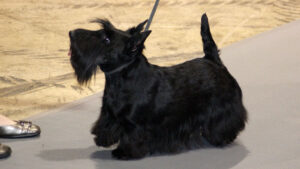
Evaluating the Scottish Terrier: a guide to recognizing their unique structure, temperament, and grooming essentials in the show ring.

Discover the joy of Scottish heritage at the 2024 Tartan Day Parade, featuring bagpipers, dancers, and adorable Scottish dog breeds.

Dr. Danica Burge is the breeder behind J-Mar Scottish Terriers. Read about the kennel’s beginnings, champion dogs, puppies, photos & more!

Kelli Edell is the breeder behind Kelwyn Scottish Terriers. Read about the kennel’s beginnings, Scottish Terrier puppies, and much more!
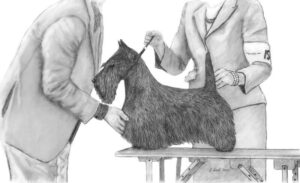
Dive into the Scottish Terrier’s essence with Evelyn Kirk’s “The Lovely Fire,” enriched by AKC insights and illustrations.

Scottie owners are devoted, like their dogs. Discover the unique bond, traits, and challenges of owning a Scottie.

Guidelines for properly examining Scottish Terriers, highlighting AKC protocols and breed-specific standards by Kathi Brown.

Reflecting on over forty years of judging Scotties, memorable mentors, key breed traits, and the importance of proper grooming.

Evaluating the Scottish Terrier: a guide to recognizing their unique structure, temperament, and grooming essentials in the show ring.

Discover the joy of Scottish heritage at the 2024 Tartan Day Parade, featuring bagpipers, dancers, and adorable Scottish dog breeds.

Dr. Danica Burge is the breeder behind J-Mar Scottish Terriers. Read about the kennel’s beginnings, champion dogs, puppies, photos & more!

Kelli Edell is the breeder behind Kelwyn Scottish Terriers. Read about the kennel’s beginnings, Scottish Terrier puppies, and much more!

Dive into the Scottish Terrier’s essence with Evelyn Kirk’s “The Lovely Fire,” enriched by AKC insights and illustrations.
The best way to ensure a long and happy relationship with a purebred dog is to purchase one from a responsible breeder. Not sure where to begin?
Contact the National Parent Club’s Breeder Referral Program, which is listed on the AKC Breeder Referral Contacts page.
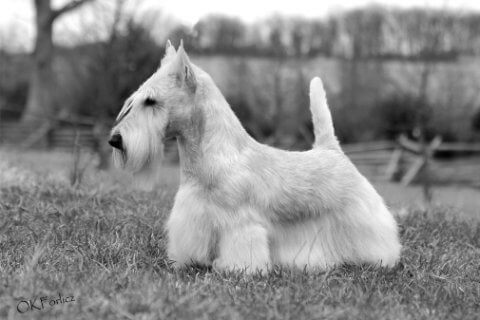

"*" indicates required fields
Showsight Magazine–the world’s most influential purebred dog publication since 1992. Each issue reaches a global audience dedicated to preserving the history and health of purpose bred dogs. Filled with award-winning editorial focused on news and insights from the dog show community, top breeders, handlers, AKC Judges, and more!